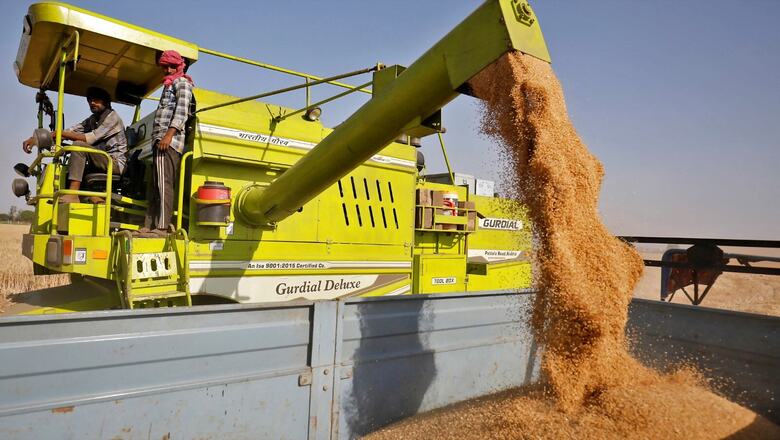
views
The ongoing war between Russia and Ukraine is all set to be “aapda mein avsar” (opportunity in disaster) for the country’s rural economy. There could be a silver lining for India with an upsurge in rural sentiments as harvesting of Rabi crops is in full swing and prices are at an all-time high, more than the Minimum Support Price (MSP) in domestic open markets as well as in global markets. The MSP of wheat is Rs 2,015 per quintal, whereas the trading price in the open market is in the range of Rs 2,200 to Rs 2,300 per quintal.
In April 2022, the prices of wheat in open markets were up by 17%, mustard by 30%, barley by 67% and soybean by 36%, in comparison to April 2021. Mustard, the second most important Rabi crop in India, has seen a 30% higher sowing in FY22 versus FY21 and will be the second-largest contributor to farm income this year.
It is broadly estimated by the known international brokerage firms that due to the Ukraine-Russia conflict, the high prices of commodities in domestic and global markets may infuse extra Rs 31,000 crore income into the rural economy from Rabi crops.
Ukraine is among the largest global exporters of wheat with a share of 12%, sunflower 47%, barley 17%, rapeseed 20% and maize with a share of 14% of global exports. Russia also has a strong presence with global exports of sunflower at 25%, wheat 18%, and 14% in barley. In the case of maize, Ukraine accounts for 13% of the global trade, with half its export consignments moving towards the lucrative European Union market.
“A ban on Russian flights to Europe and the US also means opportunities for Indian exporters of processed food, nuts, fruit juices, confectionery, pulse and cereal preparations,” said an analysis by the Agricultural and Processed Food Products Export Development Authority (APEDA), an agency under the Union Ministry of Commerce and Industry.
There is a huge scope for increasing wheat export in the current scenario. The prolonged conflict is an opportunity for India to create a market for itself in the world of wheat exports by exporting quality wheat like Basmati rice so that Indian wheat remains in demand even after the crisis.
We must not explore a new market for temporary gains coming out of the Russia-Ukraine crisis. Instead, we want to forge a long-term relationship with each of the key markets.
The total wheat market in the world is hovering around 2,100 lakh tonnes. After China, India is the world’s second-largest producer of wheat at about 1,008 lakh tonnes in 2020-21, contributing around 15% of the world’s total production while a major chunk of it goes towards maintaining food stocks for strategic domestic consumption.
At present, the warehouses are overflowing with more than 230 lakh tonnes of wheat stocks against a buffer norm of 70 lakh tonnes and the new crop will start reaching in a week. While having 400 lakh tonnes of wheat stock in 2016, India was hardly a wheat exporting nation.
In 2016, India’s global share was just 0.14% and has increased to 0.54% in 2020; even today, it’s less than 1% with a global export, and had exported about 78.50 lakh tonnes in 2021-22, 21.55 lakh tonnes in 2020-21 and only two lakh tonnes in 2019-20.
The share of Russia and Ukraine in the wheat export basket was 30% i.e 420 lakh tonnes and 240 lakh tonnes, respectively, for 2021-22. To fill up this gap in the global market, India is drawing up a strategy to step up the country’s wheat exports to a record of 100-150 lakh tonnes in the fiscal year 2022-23. To achieve these targets, logistical bottlenecks in the international freight markets must be tackled well.
Challenges for Punjab and Haryana
Gujarat and Madhya Pradesh have been exporting wheat since last year to the South Asian neighbouring countries but export from other wheat-producing states, especially Punjab and Haryana, will be challenging because of the absence of requisite transportation infrastructure, higher cost of transport to seaports in the western region, and higher levies on grain purchase.
While Madhya Pradesh government has extended a waiver of Mandi fee and other levies aggregating 3.5% on grain purchases, in a bid to boost wheat export, Punjab has not made any export-pro announcement.
The high rate of taxation here is another deterrent. The taxation system of Punjab is discouraging as exporters will have to pay 8.5% levies including a 3% market fee, 3% rural development fund, and 2.5% commission more than any other state.
Opportunities
Now the entire world is banking on India for the supply of wheat, adding that the price of the commodity in the international market has skyrocketed, which will help exporters, as well as farmers, make a quick buck. Between now and July, no fresh wheat arrival is expected from anywhere in the world except India.
Though Ukraine and Russia wheat crop will mature in August and September, no one knows the extent of damage in the wheat fields and godowns, and ports of the war-torn countries will remain isolated for quite a long time.
Australian wheat, which competes with Indian wheat, will arrive only in November, thus wheat growing in India’s states must be ready to export. We have to take up the challenge with a global dimension. It’s high time that the green revolution led by Punjab and Haryana in late 60s lead to the agriculture export revolution to catch up with the demands of the world in terms of providing wheat.
The states cooperative agencies like Markfed Punjab and Hafed Haryana can explore the benefit of wheat export this time rather than sell wheat flour in the domestic market. It can save the logistics and processing expenses on wheat and the same dividend can be shared with farmers as a special bonus of Rs 250-300 per quintal on MSP.
Against this macroeconomic backdrop, the war has created an unlikely opportunity for Indian agri-exporters who trade in wheat, maize, millet and processed food. Since the crisis unfolded last month, the world has been looking to Indian wheat to fill the huge void in stocks caused by the turbulence in Europe’s breadbasket.
The Way Ahead
It is unlikely that India will make a bid to capture every market vacated by Russia and Ukraine this year. Earlier in March, Ukraine had banned the export of wheat, oats, millet, sugar, cattle and cattle by-products, mainly to ensure that the nation, wrecked by Russian missiles, has enough stock to feed its population as the country’s supply chains are getting majorly disrupted.
If we go by the 2020-21 numbers, the lion’s share of Russian and Ukrainian wheat was exported to nations such as Egypt, Indonesia, Turkey, Nigeria, Italy and Bangladesh. India must focus on these nations. Setting up a special task force on agri-exports with representatives from the commerce ministry, FCI and states procurement agencies, railways, shipping, ports and exporters will boost the country’s rural economy in a big way.
The writer is Vice Chairman, Punjab Planning Board; Chairman ASSOCHAM Northern Region Development Council. The views expressed in this article are those of the author and do not represent the stand of this publication.
Read all the Latest Opinion News and Breaking News here

















Comments
0 comment